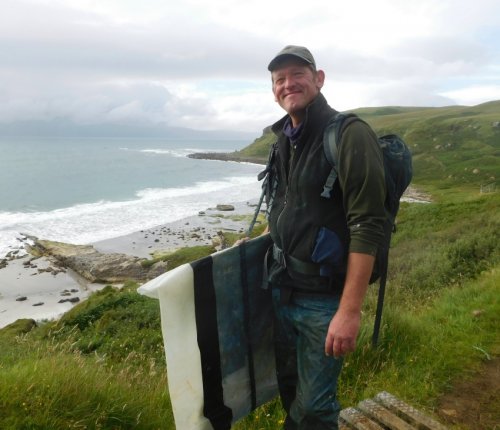
The Countryman Interview
A man for all seasons If you’re ever moved to take a walk on Dartmoor in a mid-winter thunderstorm, you might come across Stewart Edmondson, feverishly painting in a portable fisherman’s shelter. Or you might find him working as the rain courses down his canvas, alive to the velocity, height and impact of the drops. “Winter’s a fantastic season for painting the moor,” says Stewart. “I love colossolly-bad weather and great sweeps of storm powering down to earth. On one occasion, I saw these big clouds coming over - I was there with it – snow swirling. The colours are so fantastic. The bracken around Hound Tor is a dark red-orange. But it can be best just after a storm when the light’s coming down and the bracken’s still wet.” Stewart is especially aware of how things change as each season starts to come in. “In spring,” he says, “there’s a lot going on very quickly,” and he’ll sometimes camp out in the woods to catch the changes. “There are wild daffodils in Hembury Woods, the colours of the earth are burnt sienna and umber, and the leaf mould’s a dark reddy-brown. Then there’s the brightness of the first leaves on the beech trees – a colour that’s breathtaking. It can be pouring down with rain, but it still looks as though the sun’s out because of that incredibly bright green.” He finds summer the most difficult season to capture as there’s less variation of colour: “The moor’s all green. It’s very different from autumn when there’s a contrast between the light on the water and the colour of the leaves. As summer changes to autumn out at Coombestone Tor and Bench Tor, you get the reds of the hawthorn and rowan berries, the mix of heather and gorse, and large flocks of fieldfares and redwings coming in from Scandinavia. I like clouds too, and you get more in autumn - more moody skies. It’s just a joy.” Being still in a natural setting can bring all manner of surprises. He recalls a day spent below Hound Tor near the remains of a medieval village when he was visited by a barn owl, hovering only a metre or so above his head for a full twenty minutes before swinging round and silently floating away. When Stewart goes out to paint, the choice of place is uppermost in his mind. “It’s a case of what I’m most moved to do that day. I go for whatever’s on fire for me. I might do two or three paintings in a bluebell wood and then I’d have to do something else.” His concentration is so intense that he finds there’s a great difference in his apprehension of a place between arriving and leaving. “I just notice so much more because my level of perception has deepened so much. I could do ten more paintings. But next day, of course, it’s all changed.” He will often begin work by doing simple sketches of light and dark structures for twenty minutes or so. He paints with a watercolour base and acrylic ink, often quickly scratching off paint with his finger nails or a sharp knife to achieve a particular tone. He admits to naivety in his use of colour, but he’s fascinated by vibrations of colour in the natural world. Tall, loose-limbed and tanned, he talks with his body, constantly shifting position as he speaks. When I ask a question, he will frequently throw his head back and laugh – as though this were something impossible to answer. Then he goes quiet and it’s clear that he’s thinking deeply. Then he bursts forth with a passionate
